.
Parts: 1 - 2 - 3 - 4 - 5 - 6 -
Foot Race
For men and boys (paides)
1 Stadion (στάδιο)(since 776 BC, first winner Coroebus of Elis , a mageiros (a priest ?) interpreted by some as a cook)
Running 600 feet or 1 stadium. (up to 20 athletes)
Diaulos (δίαυλος) (since 724 BC, 14th Olympiad, first winner Hypenus of Elis ):
2 Stadia, i.e. 1200 feet distance. The runners had to turn around the post at the far end and then return.
Dolichos (δόλιχος)(long race) (since 720 BC, 15th Olympiad, first winner Acanthus of Laconia)
Around 7-24 Stadia? or around 1.5 - 5 km. For all races one has to consider that the running was performed without shoes on sand which can be painful (Try and see!). For men I assume running nude can be painful also for another reason. A solution of this problem was probably the so-called kynodesme a leather strip binding the penis (called by the Athenians kyon or dog). An image of an athlete with a kynodesme
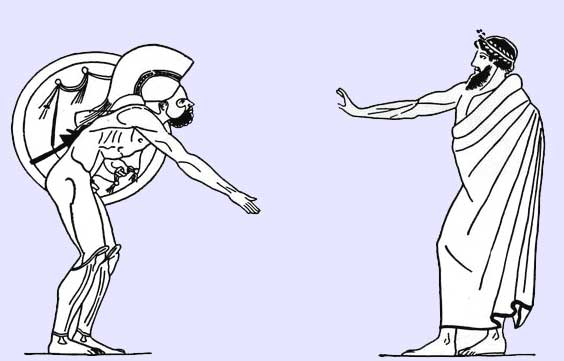

Amphora, Louvre No. G214, Hoplitodromos, Runner waits the start signal
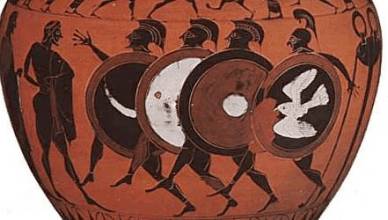
Hoplitodromos (οπλιτόδρομος, &omicronπλίτης) (since 520 BC in Olympia, first winner Damaretus of Heraea, 65th Olympiad, in Delphi since 498 BC)
2 Stadia (a diaulos) with armed warriors running with full equipment (around 60 lbs weight).The race is over a distance of around 400 metres, which is the distance covered by the enemy archers. During the battle of Marathon the Greek army used a tactic described by Herodotus where the Phalanx moved as fast it could towards the Persian army when it was in the range of the Persian archers.
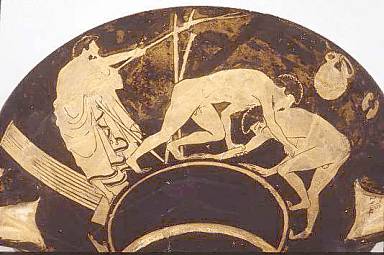
Wrestling, supervised in order to avoid rule violations |
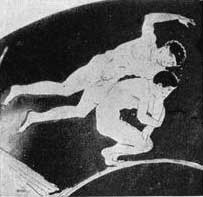
Wrestling scene from a Kylix, British Museum E94
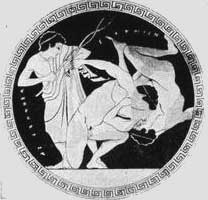
Kylix, Bibliotheque Nationale Paris, No. 523
|
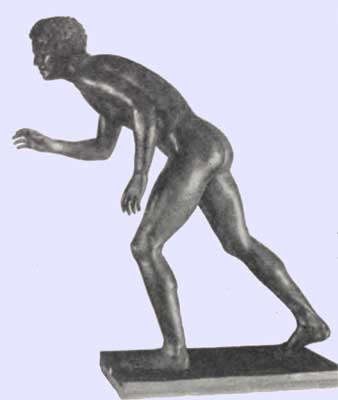
Wrestler , (part of a pair) National Museum of Naples, See a reconstruction in the Achilleion in Corfu
Wrestling (πάλη, since 708 BC, 18th Olympiad, first winner Eurybatus of Laconia ). The athletes oiled like in a wrestling sport today in Turkey (Kirkpinar) although the Greek athletes were nude. Variations: upright and ground wrestling (ορθία &piάλη, κάτω &piάλη). For the upright version the goal was to throw the opponent 3 times to the ground. (No weight classes) (events for men “andres” and beardless youths “agenioi”)
For Theseus was the first to discover the art of wrestling, and through him afterwards was established the teaching of the art. Before him men used in wrestling only size and strength of body. Pausanias
Wrestling Image
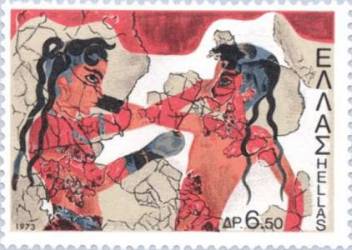
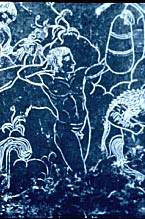
a) Boxing of Minoans and b) box training of Polydeukes with a korykos (300 BC)(Source )
See also Ferrence, Susan "Deformity in the "Boxing Boys"", Perspectives in Biology and Medicine - Volume 48, Number 1, Winter 2005, pp. 105-123 (suggests that there is a sport related injury / body deformation visible for one of these boxing children)
Boxing (πυγμή, since 688 BC, 23th Olympiad, first winner Onomastus of Smyrna) but a much older sport as shown in an image from Thera (mentioned also by Homer). Pieces of metal could be used to the boxing gloves! (wrapped leather pieces). No weight classes like today There was in principle no time limitation (a special rule, the klimax, allowed to keep the time within reasonable limits not allowing to try to avoid hits after some time) Victory was decided by an opponent falling to the ground or raising one or two fingers showing defeat. Surprisingly Apollo was considered as the inventor of boxing being victorious against Ares the god of war in a boxing fight. The athletes wear leather strips wrapped around their hands, the so-called himantes which were not used only for protection but the hits were more painful for the opponent.
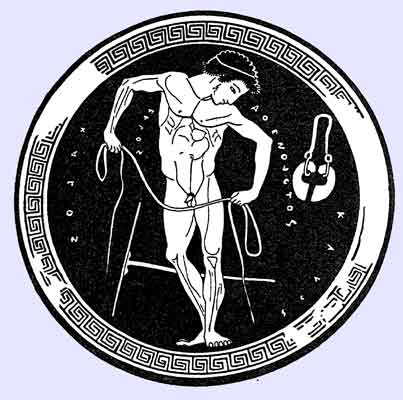
Boxer ready to wrap a leather strip around his hand, Panaitios painter, later than 500 BC. Halteres on the wall for used in the jumping event.
Boxer and Apoxyomenos, Vienna, Kunsthistorisches Museum, 1091
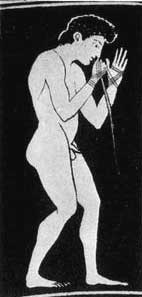
Boxer wraps his fist with a leather strip, Kylix, Berlin Museum No. F 2262, Epiktetos
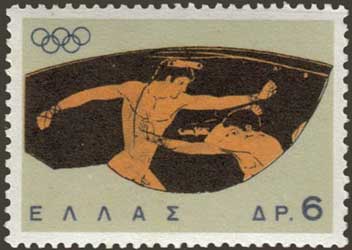

Kylix, Altes Museum Berlin F 2284, Douris, one athlete holds up his forefinger as a sign of defeat boxing, Olympia stamp 1964

Boxer, Koblanos of Aphrodisia
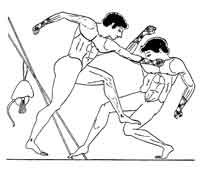
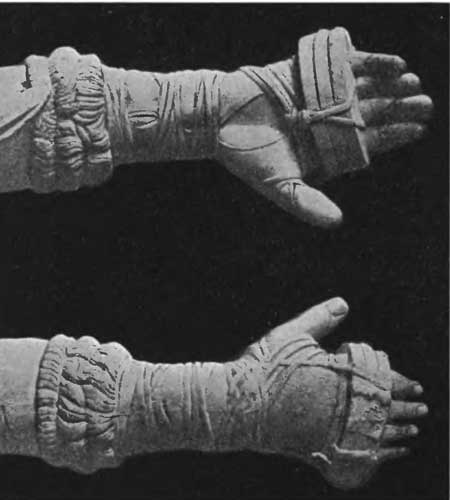
Seated Boxer, "Gloves"
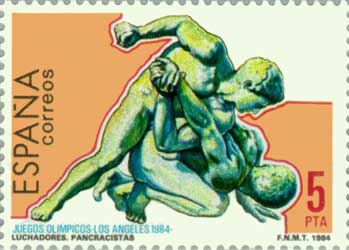
Uffizi Wrestlers based on 3rd century BC Greek original
Uffizi Wrestlers, Louvre copy
Pancration (παγκράτιο, from pan krates i.e. all strenght) wrestling (648 BC, 33th Olympiad, first winner Lygdamis of Syracuse). Versions a) Ano (άνω) (upright) and b) Kato (κάτω) (ground) version
Kicking and hitting were allowed; only biting and gouging (thrusting a finger or thumb into an opponent's eye) were forbidden. The event could be very brutal, too much that could today be accepted (with the exception of some martial games in the United States).There are cases of athletes who died (but even today there are such cases in boxing or other Games). Arrachion of Phigalis as said, being strangled by his opponent and almost loosing consciousness, twisted his foe’s leg. He inflicted such pain that the opponent lifted his hand to signal defeat. But as the judges declared Arrachion as the winner, he lay dead before them. Strangling was allowed as Hyperides says: Was I so insane that, with so many other people coming along, including Dioxippos and Euphraios his fellow-wrestler who are said to be the strongest of the Greeks, I was not ashamed of saying such things about a free woman with everyone listening, and I was not afraid of being strangled to death on the spot? Speeches. In Defense of Lycophron.
Preparation of wrestlers and boxers
A boxer fastening his gloves
Pentathlon (πένταθλον) since 708 BC, 18th Olympiad first winner Lampis of Laconia. Penta means five in Greek and the Pentathlon athletes had to complete 5 events (not all necessary as winning three events was enough and the remaining events were canceled). Probably wrestling was the last event of the Pentathlon. Boys’ Pentathlon held only in 628 BC. According to Philostratus it was Jason the leader of the Argonauts who in Lemnos "invented" the Pentathlon.(or Peleus according to Aelius Aristides, Panath. 195,18).
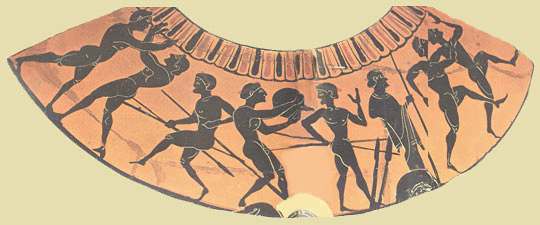
Pentathlets, like bodybuilders probably as a result of intensive training.
Parts: 1 - 2 - 3 - 4 - 5 - 6 -
Index Greek Life



















